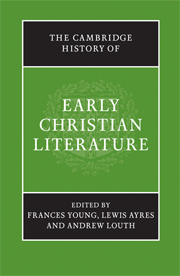Book contents
- Frontmatter
- PART ONE The Beginnings: The New Testament to Irenaeus
- PART TWO THE THIRD CENTURY
- PART THREE FOUNDATION OF A NEW CULTURE: FROM DIOCLETIAN TO CYRIL
- A LITERARY GUIDE
- 21 Classical genres in Christian guise; Christian genres in classical guise
- 22 Arnobius and Lactantius
- 23 Eusebius and the birth of church history
- 24 The fourth-century Alexandrians: Athanasius and Didymus
- 25 Palestine: Cyril of Jerusalem and Epiphanius
- 26 The Cappadocians
- 27 Fourth-century Latin writers: Hilary, Victorinus, Ambrosiaster, Ambrose
- 28 Jerome and Rufinus
- 29 Augustine
- 30 John Chrysostom and the Antiochene School to Theodoret of Cyrrhus
- 31 Cyril of Alexandria
- 32 Hagiography
- 33 Ephrem and the Syriac Tradition
- 34 The literature of the monastic movement
- 35 Women and words: texts by and about women
- 36 Conciliar records and canons
- B CONTEXT AND INTERPRETATION
- Bibliographies
- Index
- Map: The Roman Empire in the late fourth century AD"
- References
21 - Classical genres in Christian guise; Christian genres in classical guise
from A - LITERARY GUIDE
Published online by Cambridge University Press: 28 March 2008
- Frontmatter
- PART ONE The Beginnings: The New Testament to Irenaeus
- PART TWO THE THIRD CENTURY
- PART THREE FOUNDATION OF A NEW CULTURE: FROM DIOCLETIAN TO CYRIL
- A LITERARY GUIDE
- 21 Classical genres in Christian guise; Christian genres in classical guise
- 22 Arnobius and Lactantius
- 23 Eusebius and the birth of church history
- 24 The fourth-century Alexandrians: Athanasius and Didymus
- 25 Palestine: Cyril of Jerusalem and Epiphanius
- 26 The Cappadocians
- 27 Fourth-century Latin writers: Hilary, Victorinus, Ambrosiaster, Ambrose
- 28 Jerome and Rufinus
- 29 Augustine
- 30 John Chrysostom and the Antiochene School to Theodoret of Cyrrhus
- 31 Cyril of Alexandria
- 32 Hagiography
- 33 Ephrem and the Syriac Tradition
- 34 The literature of the monastic movement
- 35 Women and words: texts by and about women
- 36 Conciliar records and canons
- B CONTEXT AND INTERPRETATION
- Bibliographies
- Index
- Map: The Roman Empire in the late fourth century AD"
- References
Summary
Often designated the ‘Golden Age of Patristic Literature’, the fourth and fifth centuries provide us with a mass of material which carries weighty literary and theological significance. For this was the period which later ages looked back to as that in which the authoritative ‘Fathers of the Church’ set out the faith handed down to them, and there is an important sense in which this determined the transmission of earlier texts as well as those originating in this period. It was also a time in which classical genres appeared in Christian guise, and Christian genres achieved their classic form.
There are, of course, discernible continuities and discontinuities with what has gone before. These can best be focused by noting two determinative moments for the character of Christian literature. The first marks the beginning of the period: the final attempt to eradicate Christianity followed by Constantine’s patronage of the Church. The second is the reaction to Julian’s attempt to reverse what had happened and construct a revived paganism sufficiently robust to challenge the power of this new kind of religion with credal foundation and institutional scaffolding. The latter will throw retrospective light on the former.
Keywords
- Type
- Chapter
- Information
- The Cambridge History of Early Christian Literature , pp. 247 - 258Publisher: Cambridge University PressPrint publication year: 2004



